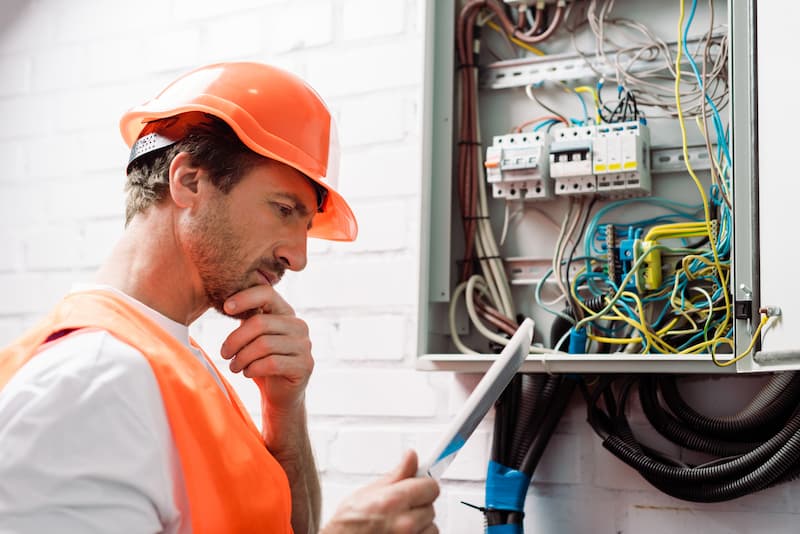Reliable regulatory compliance assistance guidance for peace of mind.
Reliable regulatory compliance assistance guidance for peace of mind.
Blog Article
Top Tips for Effective Electric System Troubleshooting
Fixing electrical systems requires a methodical technique, based in a thorough understanding of electrical principles and safety protocols. The nuances of effective fixing extend past plain technical knowledge; recognizing just how to document findings and prioritize safety can significantly affect end results.
Understand the Essentials
Recognizing the essentials of electric systems is crucial for reliable troubleshooting, as a solid structure enables service technicians to identify and fix concerns much more efficiently. A comprehensive grasp of electric principles, such as voltage, existing, resistance, and power, is vital in identifying the origin of issues. Voltage is the electric prospective difference that drives existing with a circuit, while resistance opposes the flow of existing, influencing the general functionality of the system.
Knowledge with circuit elements, consisting of resistors, capacitors, diodes, and changes, is also vital. Each component plays an unique duty in circuit behavior and can influence performance when malfunctioning. Furthermore, understanding collection and identical circuit setups is vital, as these plans affect the circulation of voltage and existing within the system.
Moreover, understanding of safety procedures is vital. Service technicians have to understand prospective threats, such as shock and brief circuits, to implement secure troubleshooting practices. By understanding these fundamental principles, professionals boost their capability to carry out efficient diagnostics and repair work, eventually causing enhanced efficiency and reliability of electric systems. This foundational knowledge is the foundation of successful fixing endeavors.
Gather Necessary Equipment
Effective troubleshooting of electrical systems needs the appropriate collection of devices to detect and solve problems properly. A fully equipped specialist can substantially improve efficiency and effectiveness in recognizing troubles. Vital tools consist of a multimeter, which determines voltage, current, and resistance, allowing for specific examinations of electrical components. Secure meters are likewise important for measuring existing without detaching the circuit, making certain security and benefit.
In addition, protected hand devices such as screwdrivers, pliers, and wire strippers are essential for securely adjusting electric connections. It is likewise a good idea to have a circuit tester on hand to verify the visibility of voltage in outlets and wires. For even more complicated systems, a thermal imaging electronic camera can assist identify overheating elements, showing prospective failings.

Comply With an Organized Method
Having actually collected the proper devices, the next action in fixing electric systems is to follow a methodical strategy. A methodical strategy makes certain that service technicians can recognize mistakes efficiently and precisely, decreasing downtime and preventing unnecessary repair services.
Begin by examining the system's schematic layouts and specifications. This entails monitoring each component methodically, starting from the power resource and functioning in the direction of the load.
Use testing devices, such as multimeters and oscilloscopes, to collect unbiased data regarding voltage, current, and resistance at various factors within the system. This empirical proof will lead your troubleshooting efforts and aid to verify or remove possible reasons of failing.
Furthermore, consider environmental variables that may affect the system's performance, such as temperature fluctuations or dampness access. A detailed inspection of electrical wiring, links, and elements will ensure that all opportunities are made up.
Paper Your Findings
Complete paperwork is crucial in the troubleshooting procedure of electric systems. This practice not only help in recognizing the origin reason of the problem however likewise offers as a recommendation for future fixing efforts.

Furthermore, preserving a log of parts replaced or repair work done is important. This details supports inventory administration and can assist analyze the longevity and reliability of certain components.
Eventually, the documents procedure need to be complete yet concise, making it possible for simple retrieval and testimonial - electrical system troubleshooting. By focusing on thorough documentation, professionals can produce an important expertise base that not only help in present troubleshooting but also empowers future upkeep initiatives, thus improving total system reliability

Prioritize Precaution
Identifying the intrinsic risks connected with electric systems is important for guaranteeing safety throughout troubleshooting. Electric technical support for electrical industry shock, burns, and tools damage are simply a few of the potential threats that service technicians face. Prioritizing precaution is not just a legal commitment however also a moral necessary that safeguards both the professional and the surrounding environment.
Before starting any type of troubleshooting task, service technicians must don suitable personal protective equipment (PPE), including protected handwear covers, safety and security glasses, and flame-resistant apparel. Making certain that the workplace is dry and complimentary of mess can dramatically lower the threat of accidents. Moreover, it is vital to de-energize circuits before starting any kind of job, validating that they are not live via making use of a multimeter or voltage tester.
Developing clear communication procedures with team participants is additionally essential; this makes certain that everyone recognizes possible threats and the standing of the electrical system being serviced. Having an emergency feedback strategy in area can show invaluable in the occasion of an incident. By focusing on precaution, professionals can properly minimize threats and promote a safer workplace.
Conclusion
Efficient electric system fixing depends on an extensive understanding of fundamental concepts and a methodical strategy. By collecting necessary devices, sticking to methodical examination strategies, and thoroughly documenting searchings for, the troubleshooting procedure becomes more effective and reputable. Focusing on precaution guarantees the well-being of individuals entailed and the integrity of the electric system. Carrying out these methods will improve the repairing experience, leading to quicker resolutions and enhanced functional efficiency in electric systems.
Report this page